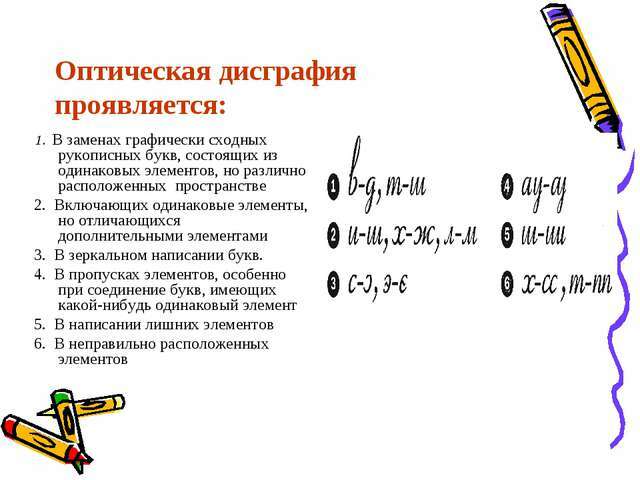 Dysforography - the child's lack of ability to learn the spelling, skills and abilities associated with it. This disorder is associated with insufficient development of speech functions, visual and auditory attention and perception, memory and thinking. This disorder is not sufficiently studied, in contrast to dysgraphy.
Dysforography - the child's lack of ability to learn the spelling, skills and abilities associated with it. This disorder is associated with insufficient development of speech functions, visual and auditory attention and perception, memory and thinking. This disorder is not sufficiently studied, in contrast to dysgraphy.
Dysgraphy is a violation of written speech, which is caused by the disruption of the work of mental processes and analyzers, responsible for the formation of the writing skill.
Both disorders are separate, independent of each other. However, quite often they can be found together in one patient.
Content
The development of dysorptography and dysgraphia occurs for various reasons, but some factors may overlap. The occurrence of a violation of written language can be associated with various injuries and inadequate development of brain areas due to negative factors during the period of gestation, as well as in the birth and postnatal period.
To such reasons carry:
- during pregnancy with the presence of pathologies and diseases;
- deficiency of oxygen in the child during childbirth;
- birth injury of a newborn;
- encephalitis;
- meningitis;
- diseases caused by infections;
- is a disease of a somatic nature.
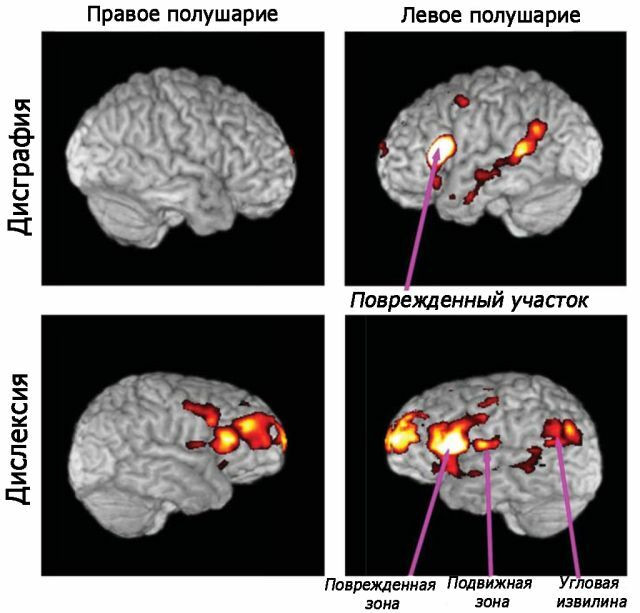
These disorders are associated with abnormalities in the development of the brain and traumas of the prefrontal cortex, parietal lobe, anterior cingulate cortex and basal nuclei. These areas are responsible for the correct functioning of the working memory.
Correct development of writing skills is impossible without correctly formed oral speech, possession of lexical and grammatical aspects of speech, possession of perception and pronunciation skills of sounds. Violation of these processes occurs when there is a pathology of development of the speech apparatus and causes of organic origin.
The social and psychological factors can also lead to the development of writing disorders in the child:
- bilingual family( bilingual);
- speech disorders or wrong speech in surrounding people;
- lack of voice communication;
- lack of attention of surrounding adults to the speech of the child;
- is too old to start learning the letter.
The most common dysgraphy and dysphorphography is observed in younger schoolchildren with speech disorders, mental retardation and constitutional predisposition to this.
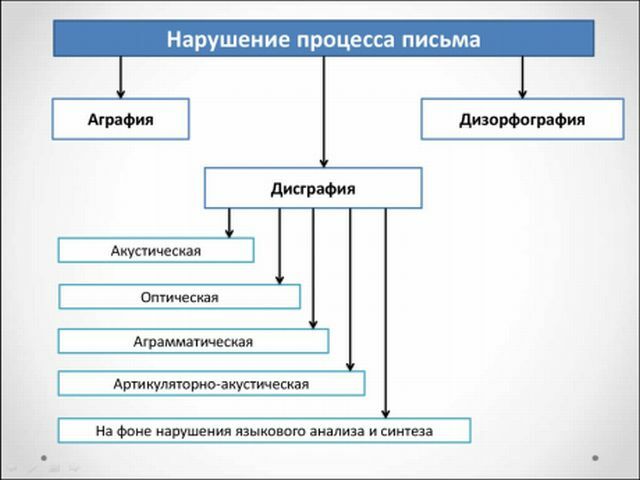
The emergence of these disorders in adulthood can be the result of neurosurgical surgery, stroke, brain injury, tumor neoplasm in the brain.
Classification of writing disorders
The following types of discography are distinguished:
- Articulatory-acoustic .In this type of violation, the child writes down the words exactly as he pronounces them. Such a problem arises from the incorrect pronunciation of sounds, and the subsequent reproduction of errors on the letter.
- Acoustic .The child has difficulty in differentiating sounds by ear. Therefore, in writing, he replaces the correct letters with those that hears. In this case, the child does not have difficulties with correct pronunciation of these sounds.
- Disgraphy caused by a violation of the ability to analyze and synthesize the language material .The child has difficulty in isolating individual words in the speech stream and further dividing them into sounds and syllables.
- Optical .Because of the reduced ability to recognize the previously seen, as well as the ability to analyze and synthesize information, the child distorts and replaces letters when performing written assignments.
- The agrammatical .When performing written assignments, the child has difficulty in identifying the linguistic and logical connection between words, phrases and sentences. Writing the essay can be accompanied by such errors: not the correspondence of the sentence sequence to the described events, the lack of a grammatical and semantic relationship between some sentences.
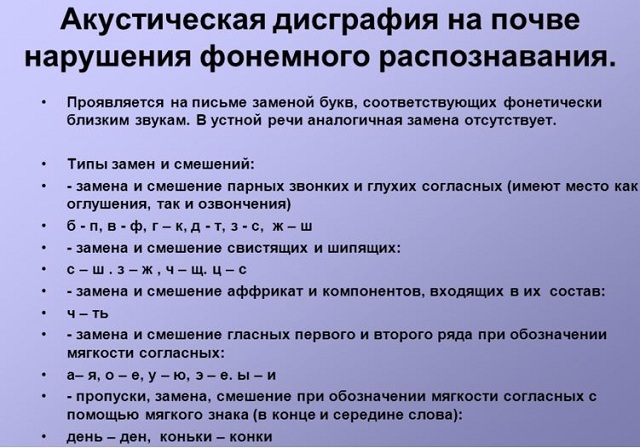
There are several types of dysorffography:
- Morphological .The child commits a significant number of spelling mistakes when performing independent written assignments( statements, compositions).
- Syntax .The child manifests an inability to master various syntactic rules, for example - punctuation.
- Mixed .At the child at performance of written tasks systematic punctuation and spelling errors are observed.
There is also a classification of dysforography, based on the severity of the disorder:
- Light .The child copes with more than half of the proposed tasks at a level above the average, and the rest of the tasks at the average or low level.
- Average .A student can complete most of the proposed assignments at an intermediate level.
- Heavy .The child performs all tasks at a level below the average, or at a low level.
Clinical manifestations of
The manifestations of dysgraphia depend on the type of disorder:
- with articulatory-acoustic pathology form the child misses letters, misses sounds in oral speech, replaces letters;
- acoustic dysgraphy is characterized by the replacement of letters, replacement of stressed vowels, paired consonants, - the child can not designate soft and firm consonants on the letter;

- in case of violation, developed due to violations of the ability to synthesize and analyze the language material , the characteristic manifestations will not be the completion of words on the letter, the movement of letters within the word, the merging of several words into one, the addition of unnecessary letters;
- with optical form infringement the child replaces one handwritten letters with others similar in appearance, replaces letters that have different number of identical elements, it is also possible to write letters in mirror projection, unfinished writing of letters;
- for The algorithmic type of is characterized by such errors: violation of the word structure, replacement of suffixes and prefixes, non-compliance of case endings, lack of agreement between words in the sentence, skipping and replacement of prepositions, distortion of the word sequence.
Dysrophography is manifested by such symptoms:
- impossibility to remember the concepts of "word", "sound", "syllable";
- the difficulty in mastering the rules of spelling( occurs more slowly than other students);
- lack of a formed skill to make inferences, to determine the sequence of actions when performing written tasks on the language;
- giving incorrect examples to the learned rules;
- misunderstanding of grammatical features of orthograms;
- difficulties in assignments for the selection of related words, parsing the word for the components of morphemes;
- ineffectiveness of performing tasks for self-testing.
Concomitant disorders
Dysgraphia is a fairly common disorder. In primary school classes, signs of this disorder can be observed in about half of children.
The number of such pupils is getting smaller by the middle school. Probably, such a spread of the disorder is due to the fact that a significant number of children go to school, having a general underdevelopment of speech and an unformed process of pronunciation of sounds and perception of phonemes. These problems make it difficult to master the skill of literate writing.
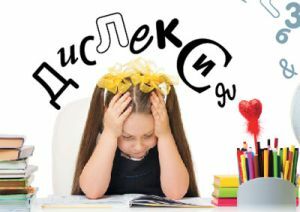 The writing skill is inextricably linked with the reading skill. Therefore, quite often the violation of the letter is combined with dyslexia and alexia.
The writing skill is inextricably linked with the reading skill. Therefore, quite often the violation of the letter is combined with dyslexia and alexia.
Dyslexia is a partial disruption of the ability to learn the reading skills. Alexia - the inability to learn the process of reading because of the violation of certain areas of the cerebral cortex( or partial disturbance of reading for the same reason).
Also often, dysgraphia adjoins such disorders as attention deficit hyperactivity disorder, dyspraxia.
What is the Dyslexia
Dyslexia is a violation of the child's mental development against the background of normal intellectual development. With this disorder, the skills of writing and reading are acquired with difficulty.
Dyslexia is a common name for violations of the formation of the skill of reading and writing. This term includes such violations as dysgraphia and dyslexia.
Characteristic features of this disorder:
- changing places of numbers and letters when writing and reading;
- multiple errors in the execution of written assignments;
- difficulties in reading texts;
- word break at pronunciation( ingestion of the ending).
Diagnostic criteria
To conduct a correct diagnosis, a comprehensive examination is necessary. Since violations of the letter may be caused by abnormalities in the auditory and visual system, the examination should include consultation of an ophthalmologist and an otolaryngologist. Identify the organic causes of violations of the letter can be examined by a neurologist.
Logopedic research will allow to determine at what level the speech function of the child is formed. Speech therapist conducts diagnostics of written speech by analyzing and studying his written works. This test helps to separate the writing disorder and a simple lack of knowledge. Then you need to pay attention to the motor skills of speech and movements, the structure of the speech apparatus, determine the left-hander or right-handed child. 
The examination should take into account the state of the child's nervous system, the absence or presence of visual and hearing impairments.
Logopedic examination includes also the study of the ability to synthesize and analyze sounds, the ability to differentiate sounds by ear, to pronounce them, to determine the structure of words. It is also necessary to evaluate the construction of speech from the point of view of grammar and vocabulary.
Written tests for detecting dysgraphy and dysphorphography include writing vocabulary and text dictations, copying typed and handwritten text, drawing descriptions to a drawing. Also such task as reading of separate syllables, syllables and whole texts is applied.
Treatment and correction of
Treatment of dysgraphia and dysrophography should be aimed at eliminating the root causes of disorders and correcting writing skills.
For the treatment of the underlying disease, the neurologist prescribes the administration of pharmaceuticals and the passage of a course of rehabilitation therapy, which may include therapeutic physical training, massage, hydrotherapy and physical therapy methods. Correction of violations is done by a speech therapist.
Techniques are applied aimed at:
- development of the skill to recognize characters visually;
- training to produce synthesis and analysis of information( compare and compare);
- development of visual, speech and auditory memory;
- teaching the child pronunciation of sounds and understanding of phonemic processes;
- formation of the ability to recognize and perform operations with objects visually and in space;
- training in the morphological principle, the syntactic system of speech;
- vocabulary enrichment;
- formation of coherent speech and "feelings of language".
Exercises and special notebooks for correction of dysgraphy in younger schoolchildren:
 Violations of the letter, often do not pass without external assistance to this. For successful correction of disorders, the help of specialists( neurologist, speech therapist and teacher) is needed, as well as the assistance of the patient's parents or the adult patient.
Violations of the letter, often do not pass without external assistance to this. For successful correction of disorders, the help of specialists( neurologist, speech therapist and teacher) is needed, as well as the assistance of the patient's parents or the adult patient.
These disorders are often associated with abnormalities in the functioning of brain areas, so a successful outcome of therapy is achieved with the participation of a neurologist in it and following its recommendations.
Correction of violations of the letter should be done with the assistance of parents and other adults from the environment of the child. The success of therapy largely depends on the patient's social environment and its impact on him.
Positive result of correctional work will depend on the development of the higher mental functions of the child. They largely affect the process of acquiring the skills of reading and writing.


